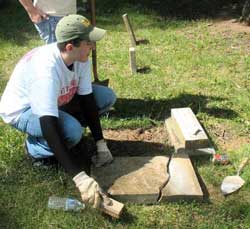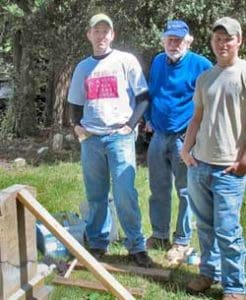Past Activities
High School History Students Repair and Restore
Gravestones at the Cemetery

Loudoun Valley High School students Elisabeth Harris (right) and Justine McDonald reset a leaning gravestone.
About a dozen Loudoun Valley High School students from Susan Stevens' Advanced Placement U.S. History class and their teacher Susan Stevens spent the better part of a Saturday clearing downed tree limbs, high grass and tangled brush as well as helping reset broken headstones at Union Cemetery, a quiet, serene 19th century burial ground located behind the Waterford Old School.
This is the second year Stevens has brought her AP history students to the cemetery, and this year was by student request. Some of last year's participants had talked so enthusiastically about the project, that the AP U.S. History students wanted to do the same thing.
The project was spearheaded by Paul Rose, chairman of the Waterford Union of Churches Cemetery Inc., a charitable organization dedicated to the care and maintenance of Union Cemetery and the adjacent cemetery for black residents.

ndrew Masters cleans a broken gravestone before it is cemented and replaced on its footinging. [Photos courtesy A. Rose]
Andrew Masters and David Roberts were among those helping clear tangled undergrowth and reset stones, with David's truck proving a godsend, according to Rose, in terms of hauling away at least two truckloads of brush.
"It was a cool experience," Andrew said of their work on the stones, noting one normally doesn't see cemeteries where names go back further than the 1930s. Seeing that connection to the past was unusual, he said.
David noted that when looking at the tombstones and the different names depicted on them, "you could tell who the big families were, who had money and who didn't."
The two students spent much of the day using pump water sprayers to clean the stones thoroughly before lifting them upright, where they had fallen over, or re-setting them in their base, and filling cracks with epoxy where they were broken.
There are more than 300 names of people known to have been buried in the cemetery, although some headstones have been lost over the years. Particularly in the black cemetery, many graves are only indentations in the ground, marked with a rock or the rusted remains of the undertaker's metal tags.
For the students, working on the gravestones and assimilating the experience of the span of centuries represented in the cemetery was a novel experience.
"Their level of involvement was really amazing," Rose said of the students as they tucked into a good barbecue sandwich from Red Hot & Blue, courtesy of the foresight of Beth Erickson, and the Waterford Citizens Association.
The Union Cemetery was laid out early in the nineteenth century and was strictly segregated, with the black section to the rear. Both sections contain fine marble monuments, but many African Americans could afford no more than a roughly flat stone brought in from some field, or just a wooden marker that quickly weathered away. The resulting gaps in the rows testify eloquently to the inequalities of the day.
Civil War veterans of both races—and both armies—lie peaceably in the same cemetery. Their graves bear appropriate military markers. One designates the grave of James Lewis (born 1844) who traveled to Pittsburgh during the war where he joined the 55th Massachusetts Infantry Regiment, a white-led black unit like the famous 54th that was immortalized in the film, Glory.
